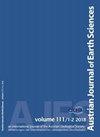反射地震和沉积物岩心分析揭示了奥地利东阿尔卑斯Mondsee湖晚冰期和全新世沉积充填与历史岩崩活动
IF 1.1
4区 地球科学
Q2 Earth and Planetary Sciences
引用次数: 7
摘要
冰川生周高山湖泊可以构成连续的末次盛冰期后(LGM)地质档案,可以重建湖泊特有的沉积过程和湖泊的古环境背景。Mondsee湖是上奥地利州Salzkammergut的几个周边高山湖泊之一,以前曾在古气候、古湖泊学和(古)生态学方面进行过研究。然而,晚冰期至全新世沉积物沉积的完整范围和环境仍然未知,并且不清楚先前研究的岩心切片是否完全代表三维沉积物堆积模式。本研究通过高分辨率地震反射测量(3.5 kHz ping源)和从湖泊最深处提取的连续长度为13.76 m的沉积物岩心,对Mondsee湖的沉积填充进行了研究。在盆地北部,由于浅层气丰富(造成声隐),地震穿透在大部分地区受到强烈限制。在较深的区域,声波信号的深度可达80 ms TWT(双向传播时间),代表了至少60 m厚度的冰后沉积序列。全新世沉积物仅构成沉积演替的最上层11.5 m。蒙德塞湖的冰川后地震地层与法国和瑞士的近高山湖泊非常相似,我们的数据显示,蒙德塞湖的大部分沉积盆地是在Traun冰川从蒙德塞地区撤退后的短时间内(19,000 BP至14,500 BP之间)沉积的,表明平均沉积速率约为1.4 cm/yr。与其他高山周边湖泊相比,Mondsee湖的地震数据显示全新世期间的大规模运动活动很少。然而,有一个例外,那就是来自一个陡峭悬崖的岩崩,位于周一湖南岸的Kienbergwand,在那里,在湖的邻近部分,地震剖面显示了质量运输沉积物(MTDs),它从岸边延伸约450米,可测绘的面积约为45,300平方米。以mtd为目标的沉积物岩心显示了两次独立的岩崩事件。较老的事件由碎屑支撑的角状白云质砾石和砂组成,显示出大量的细粒。较年轻的事件显示直径达1.5厘米的白云岩碎屑,混合在湖相泥质基质中。放射性碳定年和不同年代沉积物岩心的对比表明,事件1的年代为公元1484±7年,事件2的年代为公元1639±5年。由于我们的数据显示没有证据表明大规模的物质运动影响了蒙德塞湖及其周边地区,我们推断,目前的肯伯格湾形态是罕见的中等规模岩崩的结果。本文章由计算机程序翻译,如有差异,请以英文原文为准。
Late Glacial and Holocene sedimentary infill of Lake Mondsee (Eastern Alps, Austria) and historical rockfall activity revealed by reflection seismics and sediment core analysis
Abstract Glacigenic perialpine lakes can constitute continuous post-last glacial maximum (LGM) geological archives which allow reconstruction of both lake-specific sedimentological processes and the paleoenvironmental setting of lakes. Lake Mondsee is one among several perialpine lakes in the Salzkammergut, Upper Austria, and has been previously studied in terms of paleoclimate, paleolimnology and (paleo)ecology. However, the full extent and environment of Late Glacial to Holocene sediment deposition had remained unknown, and it was not clear whether previously studied core sections were fully representative of 3D sediment accumulation patterns. In this study, the sedimentary infill of Lake Mondsee was examined via high-resolution seismic reflection survey over a 57-km extent (3.5 kHz pinger source) and a sediment core extracted from the deepest part of the lake, with a continuous length of 13.76 m. In the northern basin, seismic penetration is strongly limited in most areas because of abundant shallow gas (causing acoustic blanking). In the deeper areas, the acoustic signal reaches depths of up to 80 ms TWT (two-way travel time), representing a postglacial sedimentary sequence of at least 60-m thickness. Holocene deposits constitute only the uppermost 11.5 m of the sedimentary succession. Postglacial seismic stratigraphy of Lake Mondsee closely resembles those of well-studied French and Swiss perialpine lakes, with our data showing that most of Lake Mondsee’s sedimentary basin infill was deposited within a short time period (between 19,000 BP and 14,500 BP) after the Traun Glacier retreated from the Mondsee area, indicating an average sedimentation rate of about 1.4 cm/yr. Compared to other perialpine lakes, the seismic data from Lake Mondsee reveal little indication of mass movement activities during the Holocene. One exception, however, is rockfalls that originate from a steep cliff, the Kienbergwand, situated on the southern shore of Lake Mondsee, where, in the adjacent part of the lake, seismic profiles show mass transport deposits (MTDs), which extend approximately 450 m from the shore and are mappable over an area of about 45,300 m2. Sediment cores targeting the MTDs show two separate rockfall events. The older event consists of clast-supported angular dolomitic gravels and sands, showing high amounts of fine fraction. The younger event exhibits dolomitic clasts of up to 1.5 cm in diameter, which is mixed within a lacustrine muddy matrix. Radiocarbon dating and correlations with varve-dated sediment cores hint at respective ages of AD 1484 ± 7 for Event 1 and AD 1639 ± 5 for Event 2. As our data show no evidence of larger-scale mass movements affecting Lake Mondsee and its surroundings, we infer that the current-day morphology of the Kienbergwand is the result of infrequent medium-scale rockfalls.
求助全文
通过发布文献求助,成功后即可免费获取论文全文。
去求助
来源期刊

Austrian Journal of Earth Sciences
Earth and Planetary Sciences-Paleontology
CiteScore
3.10
自引率
0.00%
发文量
0
审稿时长
>12 weeks
期刊介绍:
AUSTRIAN JOURNAL OF EARTH SCIENCES is the official journal of the Austrian Geological, Mineralogical and Palaeontological Societies, hosted by a country that is famous for its spectacular mountains that are the birthplace for many geological and mineralogical concepts in modern Earth science.
AUSTRIAN JOURNAL OF EARTH SCIENCE focuses on all aspects relevant to the geosciences of the Alps, Bohemian Massif and surrounding areas. Contributions on other regions are welcome if they embed their findings into a conceptual framework that relates the contribution to Alpine-type orogens and Alpine regions in general, and are thus relevant to an international audience. Contributions are subject to peer review and editorial control according to SCI guidelines to ensure that the required standard of scientific excellence is maintained.
 求助内容:
求助内容: 应助结果提醒方式:
应助结果提醒方式:


